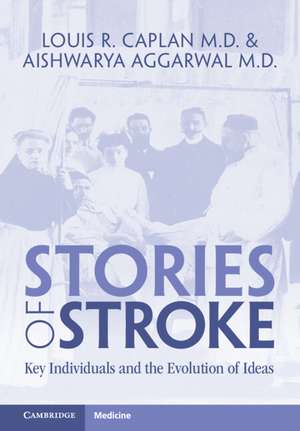Stories of Stroke: Key Individuals and the Evolution of Ideas
Autor Louis R. Caplan, Aishwarya Aggarwalen Limba Engleză Hardback – 14 dec 2022
Preț: 690.97 lei
Preț vechi: 727.34 lei
-5% Nou
Puncte Express: 1036
Preț estimativ în valută:
132.26€ • 143.71$ • 111.17£
132.26€ • 143.71$ • 111.17£
Carte disponibilă
Livrare economică 31 martie-14 aprilie
Preluare comenzi: 021 569.72.76
Specificații
ISBN-13: 9781316516676
ISBN-10: 1316516679
Pagini: 670
Dimensiuni: 182 x 260 x 36 mm
Greutate: 1.5 kg
Editura: Cambridge University Press
Colecția Cambridge University Press
Locul publicării:Cambridge, United Kingdom
ISBN-10: 1316516679
Pagini: 670
Dimensiuni: 182 x 260 x 36 mm
Greutate: 1.5 kg
Editura: Cambridge University Press
Colecția Cambridge University Press
Locul publicării:Cambridge, United Kingdom
Cuprins
Why this book needed to be written; Part I. Early recognition: 1. Hippocrates and early Greek medical practice; 2. Early Greco-Roman contributions; 3. Islamic and middle east contributions; Part II. Basic knowledge: 16th to early twentieth centuries. Anatomy, Physiology, and Pathology: 4. Andreas Vesalius; 5. William Harvey. On the motion of the heart and blood; 6. Thomas Willis. Anatomy of the brain and its vasculature; 7. Giovanni Morgagni: emphasis on Pathology; 8. Apoplexy. Ideas and concepts, 17-20th century; 9. Atlases; 10. Brainstem syndromes; 11. Jules Dejerine; 12. Arterial and Venous anatomy; 13. Rudolf Virchow; 14. Early medical and neurological textbooks; Part III. Modern era mid twentieth century to the present: A: Types of Stroke; 15. Carotid Artery disease; 16. Lacunes; 17. Vertebrobasilar disease; 18. Aneurysms and subarachnoid hemorrhage; 19. Intracerebral Hemorrhage (ICH); 20. Vascular malformations; 21. Venous and dural sinus thrombosis; 22. Arterial dissections, Fibromuscular Dysplasia (FMD), MoyaMoya disease, and Reversible Cerebral Vasoconstriction Syndrome (RCVS); 23. Blood Disorders; 24. Stroke Genetics; 25. Eye vascular disease; 26. Spinal cord vascular disease; 27. Charles foix; 28. Houston Merritt and Charles Aring; 29. C Miller Fisher; 30. Louis Caplan; 31. Cerebral angiography; 32. Computed Tomography (CT); 33. Magnetic Resonance Imaging (MRI); 34. Cerebrovascular ultrasound; 35. Cerebral blood flow, radionuclides, and Positron Emission Tomography (PET); 36. Cardiac imaging and function; 37. Stroke-related Terms; 38. Epidemiology and risk factors; 39. Data Banks and registries; 40. Pediatric stroke; 41. Care of stroke patients; 42. Neurocritical care; 43. Clinical stroke trials; 44. Heparin; 45. Warfarin; 46. New oral anticoagulants/direct oral anticoagulants; 47. Aspirin; 48. Other antiplatelets; 49. Other medical treatments; 50. Neuroprotection; 51. Thrombolysis; 52. Treatment of cerebral venous thrombosis; 53. Recovery and rehabilitation; 54. Carotid artery surgery; 55. Angioplasty and stenting; 56. Endovascular treatment of acute ischemic stroke; 57. Brain aneurysm treatment/treatment of aneurysms and subarachnoid hemorrhage; 58. Medical and surgical treatments of intracerebral hemorrhage; 59. Treatment of vascular malformations; Part IV. Stroke literature, organizations and patients: 60. Stroke organizations, journals and books; 61. Famous stroke patients/prominent stroke patients.
Notă biografică
Descriere
This book tells the full story of stroke through the experiences of many who were 'eye' witnesses to this long process.
